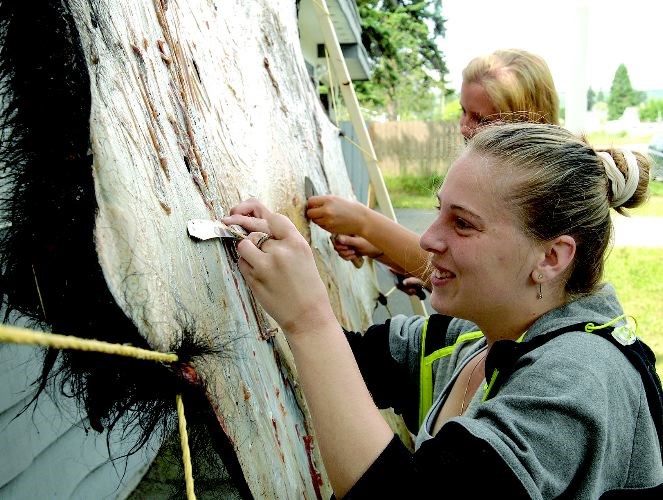An aboriginal tradition was given a new twist Tuesday in Prince George as two bison hides were scraped down to their raw base to be turned into floor drums.
Rendering animal hides has been done by local Carrier cultures for centures, but not with bison. Deer and moose are the most common, only because buffalo herds didn't exist west of the Rocky Mountains. Cree Indians and other prairie First Nations were the ones focused on bison. They were the ones who played the big powwow drums encircled by a group pounding out choral songs. Carrier people also played drums but they were hand-held due to the smaller animal hides.
Fast-forward to modern times and local farms have bison available, and the resident aboriginal profile contains a mix of almost every indigenous background.
All these factors were combined Tuesday at Hadih House, an inner city social development agency with an aboriginal emphasis. The two hides were hung out in the driveway of the Pine Street facility for anyone who wanted to give it a try to come scrape off the extraneous meat and flesh, under the supervision and instruction of veteran drummaker Clayton Gauthier.
"The important thing is to acknowledge that these animals gave their lives so these people could learn and these purposes can be served. You have to keep that spiritual connection in mind, always," Gauthier said. "In ancient times this was women's work, but now everybody can do it, and it is an important time for storytelling and sharing and passing on oral traditions."
It was soon apparent why. It is slow work to scrape off the excess materials. It has to be done carefully so as not to go too deep and slice a hole, or it won't be pristine for a drum skin. It has to be done with a sharp knife so gouge marks don't remain. Several people at a time can work away at it, with plenty of opportunity for chatter and laughter.
"This is the only part of the hunt I've never done before," said Sarah Hall, who knows she is of aboriginal descent but not which nations. "I've skinned, gutted, cut the meat, wrapped the meat, hauled it out of the bush, but I've never scraped a hide and I've never worked with a buffalo."
"I thought this was an opportunity I'd never have gotten otherwise, I couldn't pass it up," said Becky Dochstader, a non-aboriginal UNBC student from the Lower Mainland who chose to stay in Prince George over the summer. "I heard about this through PG-PIRG [the university-based Public Interest Research Group], so through weird connections you get to participate in things you'd never dream of."
Dochstader, Hall and Melissa Nitz formed the first line of the all-day scraping team. They were soon dubbed The Buffalo Gals, which added to more of the lighthearted spirit at the event.
"I haven't done this since I was a child," said Myrna Teegee, a co-ordinator for Hadih House. She and colleagues Billie Jean VanderLans and Amanda Prince organized the event.
"These buffalos were butchered yesterday. They were donated to us by Larry Nouelette of October Farms, the buffalo ranch on the highway south of town," said Prince. "This was the first, but he said he would continue to donate hides to us if we wanted them, and there seems to be a real interest. I want to start a drumming group and there is a lot of interest in that but we don't have drums, so we want to turn these hides into drums and get the group up and running."
Small girls in little pink dresses, elders, and young men in trendy T-shirts, all took turns with a knife, trimming the bits away from the tightly spread skins. Once finished, Gauthier intends to put his drummaking skills to use. On his mother's side, he is Nak'azdli First Nation from the Fort St. James beaver clan; on his father's side he is woodlands Cree with the drummaking craft passed down to him from his dad and uncles.
Hadih House has tentative plans for another hide scraping session in late August. Along with October Farms, Greig Taylor at Dollar-Saver Lumber and George Hackle at Windsor Plywood provided all the materials.



